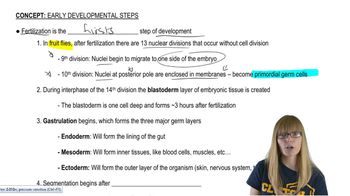Table of contents
- 1. Introduction to Genetics51m
- 2. Mendel's Laws of Inheritance3h 37m
- 3. Extensions to Mendelian Inheritance2h 41m
- 4. Genetic Mapping and Linkage2h 28m
- 5. Genetics of Bacteria and Viruses1h 21m
- 6. Chromosomal Variation1h 48m
- 7. DNA and Chromosome Structure56m
- 8. DNA Replication1h 10m
- 9. Mitosis and Meiosis1h 34m
- 10. Transcription1h 0m
- 11. Translation58m
- 12. Gene Regulation in Prokaryotes1h 19m
- 13. Gene Regulation in Eukaryotes44m
- 14. Genetic Control of Development44m
- 15. Genomes and Genomics1h 50m
- 16. Transposable Elements47m
- 17. Mutation, Repair, and Recombination1h 6m
- 18. Molecular Genetic Tools19m
- 19. Cancer Genetics29m
- 20. Quantitative Genetics1h 26m
- 21. Population Genetics50m
- 22. Evolutionary Genetics29m
17. Mutation, Repair, and Recombination
Types of Mutations
Problem 27
Textbook Question
Marfan syndrome is an autosomal dominant disorder in humans. It results from mutation of a gene on chromosome 15 that produces the connective tissue protein fibrillin. In its wild-type form, fibrillin gives connective tissues, such as cartilage, elasticity. When mutated, however, fibrillin is rigid and produces a range of phenotypic complications, including excessive growth of the long bones of the leg and arm, sunken chest, dislocation of the lens of the eye, and susceptibility to aortic aneurysm, which can lead to sudden death in some cases. Different sets of symptoms are seen among various family members, as shown in the pedigree below. Each quadrant of the circles and squares represents a different symptom, as the key indicates.

All cases of Marfan syndrome are caused by mutation of the fibrillin gene, and all family members with Marfan syndrome carry the same mutant allele. What do the differences shown in the phenotypes of family members say about the expression of the mutant allele?
 Verified step by step guidance
Verified step by step guidance1
Understand the genetic basis of Marfan syndrome: It is an autosomal dominant disorder, meaning that only one copy of the mutant allele is sufficient to cause the condition. The mutation affects the fibrillin gene, which is responsible for producing a protein that provides elasticity to connective tissues.
Analyze the concept of variable expressivity: The differences in symptoms among family members suggest that the mutant allele exhibits variable expressivity. This means that individuals with the same genetic mutation can show a range of phenotypic effects, from mild to severe.
Consider environmental and genetic modifiers: Variable expressivity can be influenced by other genetic factors (modifier genes) or environmental factors that interact with the mutant allele, leading to differences in the severity or type of symptoms observed.
Examine the pedigree: The pedigree shows that all affected individuals carry the same mutant allele, but the symptoms differ among them. This supports the idea that the mutant allele's expression is not uniform and is influenced by additional factors.
Conclude the explanation: The differences in phenotypes among family members with Marfan syndrome indicate that the mutant allele's expression is subject to variable expressivity, which is a common phenomenon in genetic disorders. This highlights the complexity of gene expression and the role of other factors in determining phenotypic outcomes.
 Verified video answer for a similar problem:
Verified video answer for a similar problem:This video solution was recommended by our tutors as helpful for the problem above
Video duration:
2mPlay a video:
Was this helpful?
Key Concepts
Here are the essential concepts you must grasp in order to answer the question correctly.
Autosomal Dominance
Autosomal dominance is a pattern of inheritance where only one copy of a mutated gene from an affected parent can cause the disorder in offspring. This means that individuals with the mutant allele have a 50% chance of passing it on to their children. In the case of Marfan syndrome, the presence of the mutant allele leads to the manifestation of symptoms, but the severity and type of symptoms can vary among individuals.
Recommended video:
Guided course

Variations on Dominance
Phenotypic Variation
Phenotypic variation refers to the differences in physical traits and symptoms expressed by individuals with the same genetic mutation. In Marfan syndrome, even though all affected family members carry the same mutant allele, they can exhibit a range of symptoms due to factors such as environmental influences, modifier genes, and the complex nature of gene expression. This variation highlights the role of genetic and non-genetic factors in determining phenotype.
Recommended video:
Guided course

Genomic Variation
Fibrillin and Connective Tissue
Fibrillin is a crucial protein that contributes to the elasticity and strength of connective tissues, including cartilage and blood vessels. Mutations in the fibrillin gene disrupt its normal function, leading to the rigidity of connective tissues. This dysfunction is responsible for the diverse symptoms of Marfan syndrome, such as skeletal abnormalities and cardiovascular issues, emphasizing the importance of fibrillin in maintaining tissue integrity.
Recommended video:
Guided course

Drosophilia Development
Related Videos
Related Practice
Textbook Question
Briefly compare the production of DNA double-strand breaks in bacteria versus the double-strand breaks that precede homologous recombination.
684
views


